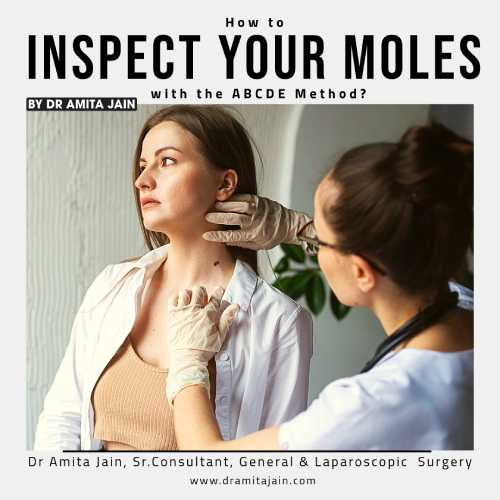When it comes to beauty, who doesn’t want a flawless skin? However, sometimes one may notice small brown or black spots appearing on various parts of the body including the face, palms, soles, nails, scalp, etc. These skin growths are called moles or nevi and are caused by clusters of pigmented cells known as melanocytes. Moles often emerge during childhood or adolescence. While most moles are harmless, some may pose a risk of skin cancer.
Some moles may look like beauty spots, while others don’t look so pleasant. Dr Amita Jain, a leading laparoscopic surgeon in India, provides insight into this matter and explains the ABCDE method for inspecting moles.
The ABCDE method is a simple yet effective guideline for identifying potentially suspicious moles, which could indicate skin cancer. Let’s understand it in detail:
A is for Asymmetry: Normally, benign moles exhibit symmetry, meaning if you were to divide them in half, both sides would match. However, cancerous moles may appear asymmetrical, with one half not mirroring the other. When inspecting moles, look for any noticeable differences in shape or contour. An asymmetrical mole should raise a red flag and prompt further evaluation by a healthcare professional.
B refers to Border Irregularity: Benign moles typically have smooth and well-defined borders. Conversely, suspicious moles may exhibit irregular, notched, or blurred borders. Run your finger along the border of the mole—if it feels uneven or jagged, it could signal a cause for concern. Border irregularity is a key indicator of potential skin cancer and warrants prompt medical attention.
C indicates Changes in Color: While most moles have a consistent color, ranging from tan to brown, suspicious moles may display multiple colors such as tan, brown, black, blue, red, or white. Pay close attention to any changes in color within the mole. If you notice new pigmentation, uneven coloring, or a combination of colors, it’s essential to seek professional evaluation. Changes in colour can signify underlying abnormalities that require medical assessment.
D is for Diameter: Moles that exceed 6 millimeters in diameter, about the size of a pencil eraser, may warrant closer inspection. While size alone does not determine the malignancy of a mole, significant growth in diameter can be indicative of potential issues. Regularly measure the size of your moles and monitor any noticeable changes. If a mole continues to grow larger over time, it’s advisable to consult a dermatologist for further assessment.

E stands for Evolution: Benign moles typically remain stable in appearance over time. However, if a mole undergoes changes such as alterations in color, size, itching, oozing, or other noticeable differences, it could be a sign of skin cancer. Pay attention to any evolving characteristics of your moles and seek medical attention if you notice any concerning changes. Early detection is crucial in the management of skin cancer, and monitoring the evolution of moles can aid in timely intervention.
Keep an eye on moles that look different or stand out from the others, as they might be signs of melanoma, a type of skin cancer. Check hard-to-reach spots like between your toes, under your breasts, and on your scalp regularly. If you have dark skin, be extra vigilant as melanomas can be harder to see. If you notice any suspicious spots following the ABCDE guidelines (asymmetry, border, color, diameter, evolving), see a doctor right away. Remember to have a professional skin cancer check every year for early detection, as not all cancerous moles follow the ABCDE rules. Early detection is crucial for effective treatment.
Last but not least, do not hesitate to consult a doctor if you observe any suspicious changes or abnormal growth on your skin. Early detection through the ABCDE method, coupled with regular professional checks, ensures timely intervention and effective treatment, vital in combating skin cancer’s potentially devastating effects.

Dr Amita Jain is one of India’s most distinguished and experienced female surgeons, known for her unmatched expertise in general and laparoscopic surgery. With over 29 years of surgical excellence, Dr Amita Jain has built a reputation for precision, compassionate care, and advanced surgical techniques.
Dr Amita Jain has successfully performed a wide range of complex general surgeries, including both open and minimally invasive procedures, with a strong focus on trauma care, onco-surgical techniques, and reconstructive surgeries. Her areas of specialisation include (including Gallbladder stone removal, appendix removal, hernia repair surgery, piles and fissure surgeries). She was the Professor of Surgery at the Army College of Medical Sciences and Base Hospital, Delhi Cantt. In 1994, she was commissioned asa Surgeon under the United Nations Mission in Congo. From 2020 to 2022, she worked with Bansals Hospital. Currently, Dr Amita Jain is the Senior General and Laparoscopic Surgeon at Rainbow Children Hospitals (Malviya Nagar, Delhi), Artemis Lite: Multi-Speciality Care Hospital (New Friends Colony, New Delhi) and at Rosewalk – Luxury Maternity Hospital in Delhi (Panchsheel Park, Delhi)
Call Us at +(91) 882-6615301